
Features
Great ideas: Innovation in the fire service
From programs to tech, innovation abounds in Canada's fire service
February 11, 2022
By Kaitlin Secord
 Photo: Adobestock/denisismagilov
Photo: Adobestock/denisismagilov Think of innovation and it often brings to mind the latest tools and tech. Equipment and technology are crucial to the improvement of fire response and firefighter safety, but the idea of innovation can also really shine in the discovery of new and better processes.
“Innovative doesn’t always necessarily have to revolve around getting the new shiny thing or the latest tech. It can involve using what you have in new ways or ways that are different than intended” said Fire Chief Bill Hunter of Perth East and West Perth fire department in Ontario.
On the west coast, Dan Wood, the deputy fire chief in Saanich, B.C., has been in the service for over 30 years and said, “a lot has changed since I started with the service, but one thing that has stayed consistent is that firefighters are some of the most innovative people you’ll ever find. It’s in the nature of the work. They have to do things on the flip of a switch. They have to problem solve faster than most and they have to do so under extremely strenuous conditions.”
Innovation is bred into the profession, and a lot of modern innovations are happening around firefighter health and safety. Through studies and research, more information has become available about how to best support mental and physical health in the fire service. The innovation and advancement of personal protective equipment (PPE) for firefighters has “improved impressively” since Wood started in the service, he said.
Innovations like lightweight, more fire-retardant fabrics, more functionality around SCBAs, and personal alert systems are helping protect more firefighters and making fire rescue more efficient.
Wood noted the process of modernizing decon as a key innovation. “Washing SCBAs and other equipment can be very time consuming and when done by hand, things are often missed. Equipment like apparatus washing stations helps to give time back to staff, which can be better used training, resting or preparing for the next call.”
Fire Chief Deryn Rizzi, and executive officer Tracy Martino, of Mississauga Fire and Emergency Services, shared the philosophy of innovation in Missaussagua as being any program or change in business processes that will reduce community risk, improve community safety and the safety of thier staff.
“Some of the most important tools for fighting fires include advanced protective gear and state-of-the-art suppression equipment. But in an age of growing communities, density issues and complex urban and rural landscapes, one of the most valuable tools in fire fighting is data,” wrote Rizzi in Igniting Insight – Using Data to Drive Decision Making.
Mississauga took an innovative data-collection approach when creating their comprehensive risk assessment model. With there being no comprehensive/ defined model for risk assessment, Mississauga “looked at NFPA 1730, obviously, which is risk defines risk, we looked at NFPA 1300, which helps with risk mitigation strategies, and the five E’s, if you will, of risk mitigation, we kind of pulled all the information together to see what this would look like,” said Martino.
This innovative approach has helped Mississauga evaluate their needs, and it helps drive their decision-making process.
“This process can go from the procurement of apparatus, equipment, the necessity of resources, and then also in terms of programming, how we’re going to program going forward,” said Rizzi.
“Innovative programs are important because we are in an environment where balancing community safety with fiscal responsibility is critical,” Martino said.
Being able to establish what works best for your community, what your department can afford or develop and how these innovations can best be implemented “is almost as challenging as fighting fires.” Hunter said. Perth East and West Perth’s Farm Fire Safety Program was created to address the growing concern of farm related fires in the region.
“Seventy-three per cent of the area’s total fire losses were made up by farm-related fires.” Hunter said, “That has dropped to 31 per cent over the last three years, since we implemented the FFSC program.”
The program is an example of innovating public education to fit your community’s needs.
“A fire department is an insurance policy for municipalities, one you hope you never have to use, but when you do use it, you want to make sure you have the best one available.” Hunter said in an interview with The Beacon Herald.
Using social media has been a great advantage for the departments of Perth East and West Perth with their most recent Fire Prevention Week being a great success.
“We saw a ton of interaction, and were excited by the progress we’ve made in the public education sphere.” Hunter said.
A goal of his is getting every member of the department certified in public education.
“This will only strengthen our ability to establish what projects are working and how to get them into the community.”
The department won a Technical Safety Standards Association award in 2015 for its carbon monoxide safety program, and has since used this model to implement other safety programs.
One of the best ways to innovate public education is through accessibility. NextGeneration 9-1-1 is on the doorstep of many departments, and will address the evolving landscape of fire departments and their communities.
“The ability to know information about an incident before getting to the scene is a game-changer,” said Wood “Not only will this help in terms of response, but it will help decrease response times, and boost communication abilities between dispatchers, first responders and our communities. It’s indispensable.”
All in all, there are many concerns to be tackled when it comes to innovation. The safety and well-being of firefighter is something that is of great focus and concern. Environmental impact is a hurdle that is tricky to tackle and expensive, but also increasingly imperative. Public education is necessary, and figuring out how to best approach it takes time and dedication.
But nothing has changed the fire service more than the availability of information.
“Our colleagues worldwide enable us to, use best practice, learn from mistakes of others. It’s really changed the way we formulate our own plans and helped us to ensure our operational guidelines are meeting rework: practices and doing what’s best to keep firefighters safe and be efficient in our jobs,” Wood said.
Equipment and tech: Innovation highlights|
Here are a few recent innovations in equipment and technology that caught Fire Fighting in Canada’s eye in 2021.
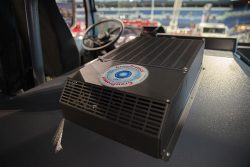 Task Force Tips (TFT) partnered with Purafil to integrate filtration technology into a new product they’ve called CrewProtect that cleans the apparatus air firefighters and EMS personnel breathe, and filters cancer causing particulate soot and volatile organic compounds, as well as a wide range of bacterial and viral threats like COVID-19.
Task Force Tips (TFT) partnered with Purafil to integrate filtration technology into a new product they’ve called CrewProtect that cleans the apparatus air firefighters and EMS personnel breathe, and filters cancer causing particulate soot and volatile organic compounds, as well as a wide range of bacterial and viral threats like COVID-19.
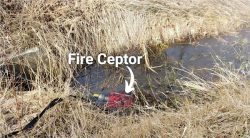 BearsPaw ProtectaPump launched a new, patented technology in Fire Ceptor, the Portable Drydrant. “Drydrant” is a new term derived from the traditional ‘dry hydrant’, which is permanent (i.e. not portable). Fire Ceptor, a made in Canada product, is designed to reduce downtime, repair costs, extend pump life, and increase performance flows and reliability. Being able to draft efficiently, and without pump destruction, is of utmost importance as climate change and increasing wildfire activity comes to the fore.
BearsPaw ProtectaPump launched a new, patented technology in Fire Ceptor, the Portable Drydrant. “Drydrant” is a new term derived from the traditional ‘dry hydrant’, which is permanent (i.e. not portable). Fire Ceptor, a made in Canada product, is designed to reduce downtime, repair costs, extend pump life, and increase performance flows and reliability. Being able to draft efficiently, and without pump destruction, is of utmost importance as climate change and increasing wildfire activity comes to the fore.
“Some of the most stressful times on the job for a rural or wildland firefighter is deciding on a drafting location that won’t damage the pump but at the same time will get the water they need in the fastest possible way. These don’t need to be two choices anymore. The goal of creating the Fire Ceptor [a suction separator] was to let firefighters not worry about where they draft. As soon as they find a body of water that’s at least six to 12 inches deep, they can be assured that it won’t affect their pump and thus be able to get to the fire as quickly as possible. At the end of the day it’s all about saving lives and property. Reducing stress and saving pump repair or replacement costs is also a nice benefit too,” said Chris Burke, BearsPaw Protectapump’s general manager of sales and marketing, in a press release. Fire Ceptor models range from two inches to four to six inches for truck-mounted pumps. Fire Ceptor has been found to have 30 per cent more flows when compared to traditional strainers, reported the company.
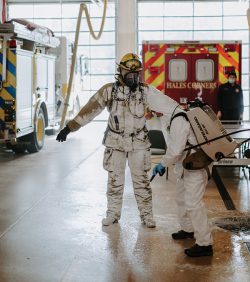 Doff ‘n DECON, a new turnout gear cleaner and decontaminate from Intelagard, aims to provide additional exposure protection from cancer. The formula neutralizes the most common carcinogens found on gear like carbon monoxide, hydrogen sulfide, and cyanide. The three-part solution uses surfactants, peroxides and a special booster to capture and lift contaminants from fabrics like Kevlar without degrading them. After mixing, the formula can immediately be applied as a foam, fog, or liquid decontaminate. Doff n’ DECON is inherently biodegradable and suitable for daily use on turnout and bunker gear, hardhats, gloves, boots, PPE tools and supplies.
Doff ‘n DECON, a new turnout gear cleaner and decontaminate from Intelagard, aims to provide additional exposure protection from cancer. The formula neutralizes the most common carcinogens found on gear like carbon monoxide, hydrogen sulfide, and cyanide. The three-part solution uses surfactants, peroxides and a special booster to capture and lift contaminants from fabrics like Kevlar without degrading them. After mixing, the formula can immediately be applied as a foam, fog, or liquid decontaminate. Doff n’ DECON is inherently biodegradable and suitable for daily use on turnout and bunker gear, hardhats, gloves, boots, PPE tools and supplies.
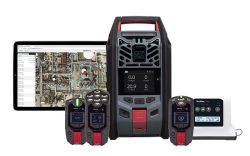 Blackline Safety rolled out its newest line of cloud-enabled G7 wearable safety devices. The configurable G7 wearables (small, wireless devices worn like a cell phone) detect gas leaks, falls and other health events in all types of business environments. They can also be used for contact tracing purposes or to determine how often workers travel through high-risk areas. The devices operate on available cellular, with optional satellite connectivity. Workers are alerted to emergency situations to facilitate evacuation and emergency response procedures, and if workers themselves are harmed or injured, their location can be pinpointed so emergency responders know exactly where to go and what conditions to expect.
Blackline Safety rolled out its newest line of cloud-enabled G7 wearable safety devices. The configurable G7 wearables (small, wireless devices worn like a cell phone) detect gas leaks, falls and other health events in all types of business environments. They can also be used for contact tracing purposes or to determine how often workers travel through high-risk areas. The devices operate on available cellular, with optional satellite connectivity. Workers are alerted to emergency situations to facilitate evacuation and emergency response procedures, and if workers themselves are harmed or injured, their location can be pinpointed so emergency responders know exactly where to go and what conditions to expect.
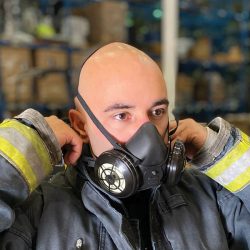 Dentec’s Comfort-Air Nx Series was developed with the aim of providing a respirator that was reusable, safer, more comfortable and more economical than disposable respirators. The reusable elastomeric rubber respirator was designed without an exhalation valve, to enhance two-way filtration protection. Its compact design reduces interference with other medical equipment. They feature eight point adjustment suspension that is intended to help users obtain a proper and comfortable fit. The Comfort-Air Nx Series is available in two sizes, with two filter options, N95 or P100. Both are designed with protection and sustainability in mind – the housings can be disinfected and reused, all while protecting the disposable filters from damage, and the reducing the user’s chance of infection. These respirators may be used in place of disposable respirators to reduce cost and waste.
Dentec’s Comfort-Air Nx Series was developed with the aim of providing a respirator that was reusable, safer, more comfortable and more economical than disposable respirators. The reusable elastomeric rubber respirator was designed without an exhalation valve, to enhance two-way filtration protection. Its compact design reduces interference with other medical equipment. They feature eight point adjustment suspension that is intended to help users obtain a proper and comfortable fit. The Comfort-Air Nx Series is available in two sizes, with two filter options, N95 or P100. Both are designed with protection and sustainability in mind – the housings can be disinfected and reused, all while protecting the disposable filters from damage, and the reducing the user’s chance of infection. These respirators may be used in place of disposable respirators to reduce cost and waste.
Print this page
Advertisement
- Suspect arrested after stealing fire truck from Toronto fire station
- Neighbours help fight Vancouver Island fire